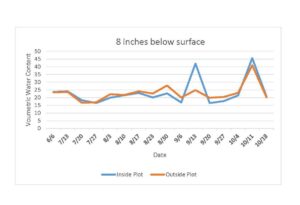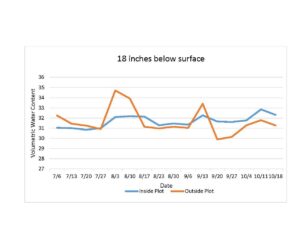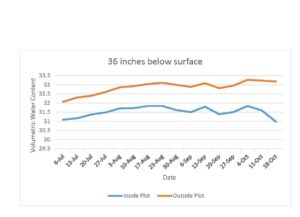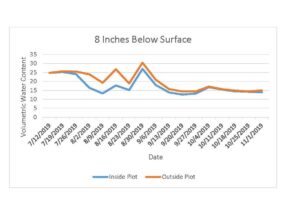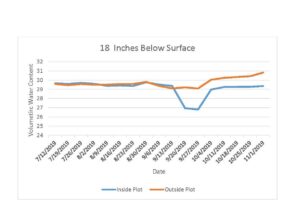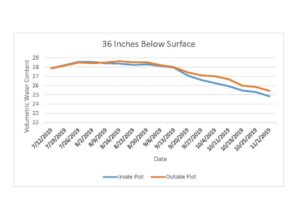Final report for ONC19-065
Project Information
Grain sorghum is a primary crop in the High Plains and is frequently planted in a no-till system. Weed management in all cropping systems is expensive for farmers due to fuel and/or herbicide costs. Kansas has documented resistance in 15 species, to six different modes of action1. Even in the most diverse cropping systems, weed management is expensive. Four Kansas famers will plant grain sorghum with a mix of companion crops selected specifically to suppress weed emergence and growth. Each grower will plant 15 dryland acres of the sorghum/companion mix adjacent to a field with only sorghum. The companion crops will be selected to suppress both the density and biomass of weeds. Each plot will be located in a cover-cropped, no-till field. Cover crops will be terminated at (or just prior to planting), before the sorghum/companion mix emerges. No pre-emergent herbicides with residual will be used. Herbicides or insecticides will not be used during the growing season. Comparisons will be made to the adjacent fields. Soil health will be analyzed by studying different indicators that demonstrate improvement. Soil moisture levels will be measured to assess the water use of the companion crops versus the weeds.
- Demonstrate appropriate companion crops can be a viable weed management alternative
- Provide demonstration plots available for others to observe and host field days
- Document results of yield variance and economic differences between companion plots and non-companion fields along with soil health benefits (ie: total carbon, infiltration, bulk density, penetration resistance, soil respiration, and macro-invertebrate population counts
- Measure the difference in available soil moisture for the sorghum inside and outside of the plots over the growing season
- Share results of the project through the No-till on the Plains network of producers and professionals
Cooperators
- (Educator)
Research
Sorghum will be planted with companion crop species to suppress weeds in lieu of crop protection chemicals The companion crop mix was designed to provide weed suppression. No-till on the Plains will work with the participating producers and a cover crop seed provider to determine the best species to meet the needs of the project objectives. Most of the companion species/mixes will be kept consistent at all of the sites, but if there are particular species that are better adapted to the local area or moisture conditions, those may be substituted or added to the mix.
The sorghum/companion plots were planted separately, but synchronized with (May/June 2018) the rest of the sorghum field. The plot acres will receive the same pre-plant treatments as the rest of the field. Once planted the plots will not receive any applications of herbicides, insecticides or post-plant fertility.
Collection of soil samples and analysis for improvement in soil health indicators will be taken to determine the benefit of using the agro-ecological principles vs the conventional system and presented at the field day and the 2020 No-till on the Plains Winter Conference.
Soil moisture probes will used at two of the sites to determine water use by the companion crops. One probe will be placed inside the plot, another probe outside the plot.
Yield Results
|
Site |
Yield Inside Plot, bu/acre |
Yield Outside Plot, bu/acre |
|
Ford County |
70 |
78 |
|
Mitchell County |
71.7 |
77.2 |
|
Osage County |
24.84 |
35.29 |
|
Saline County |
103 |
121 |
Table 2. Soil Sampling Results Inside and Outside the Test Plots
|
|
July 19 |
November 19 |
|||||
|
Sample |
Management |
% Aggregates |
Total Carbon |
Active Carbon |
% Aggregates |
Total Carbon |
Active Carbon |
|
Mitchell Co |
No Companion Crops |
58.84 |
2.5 |
493 |
36.66 |
2.0 |
415 |
|
|
Companion Crops |
53.47 |
2.2 |
477 |
22.63 |
2.1 |
440 |
|
Ford Co. |
No Companion Crops |
69.42 |
2.9 |
479 |
64.03 |
2.7 |
406 |
|
|
Companion Crops |
25.13 |
1.2 |
344 |
18.29 |
1.4 |
369 |
|
Osage Co. |
No Companion Crops |
64.05 |
2.7 |
678 |
54.99 |
2.0 |
676 |
|
|
Companion Crops |
57.22 |
3.3 |
687 |
58.65 |
1.4 |
703 |
|
Saline Co. |
No Companion Crops |
26.75 |
2.5 |
556 |
28.03 |
2.0 |
528 |
|
|
Companion Crops |
26.33 |
2.6 |
530 |
16.79 |
1.8 |
432 |
Osage County Soil Moisture Results
Mitchell County Soil Moisture Results
General Observations from the Project
- Planting date makes big impact on the success of this combination
- Pre-plant soil cover maybe the most important factor for early weed control without a quick germinating companion species
- Plot with companion crops did show greater moisture use even with early saturated soil conditions
- The mix did have positive benefits on weed populations in some of the demonstration plots, but not in every case
- Companion mix did have benefit to soils
Educational & Outreach Activities
Participation Summary:
Field day in Glen Elder, Kansas
62 individuals attended a field day featuring one of the sorghum/companion plots on Doug Palen's farm. Participants were given the opportunity to view and walk in the 15 acre plot, along with the rest of the field. Each of the companion species was identified along with the differences in soil and insect communities. Doug's plot had a significant amount of weed pressure on the edges but not excessive. The group also observed other fields of Doug's sorghum, several corn management plots, and a field that has been planted to a perennial mix for grazing. NRCS regional soil specialist Candy Thomas presented several soils demonstrations showing the benefits of soil residue, soil structure and long-term no-till versus conventional tillage methods.
Field day in Osage City, Kansas
55 individuals attended a field day featuring one of the sorghum/companion plots on Keith Thompson’s farm. Participants were given the opportunity to view and walk in the 15 acre plot, along with the rest of the field. Each of the companion species was identified along with the differences in soil and insect communities. Keith explained how the field had been previously grazed, planted to a cover crop then grazed in teh spring. Extremely wet conditions kept Keith from planting his sorghum until June 29. The group also toured Keith's sunflower companion crop field and a field planted to a perennial mix for grazing. NRCS regional soil specialist Candy Thomas presented several soils demonstrations showing the benefits of soil residue, soil structure and long-term no-till versus conventional tillage methods.
2020 No-till on the Plains Winter Conference
Sixty individuals attended the one-hour breakout session on January 29, 2020 at the No-till on the Plains Winter Conference. The four cooperators and Candy Thomas presented the results of the project. Each producer shared his experience with growing the companions and perspective for using the practice in the future. Candy Thomas talked about the soil sampling results. All 5 answered numerous questions at the end. Here's the summary presentation from 4 cooperators and soil health specialist for 2020 No-till on the Plains Winter Conference: SARE-presentation
Learning Outcomes
Most of the attendees at the field days and Winter Conference had never seen companion cropping before the field days. Several had never heard of the practice. Awareness of the opportunities for this type of production was greatly increased.
Project Outcomes
The concept of using a living plant to replace crop protection chemicals is one that is gaining momentum. Driven by the economic realities of crop production and the increasing questions by the consumer public, producers are looking for alternatives and seeking out more information about soil health and ecosystem services.
These types of demonstrations make these concepts more readily accessible to the local producers.
